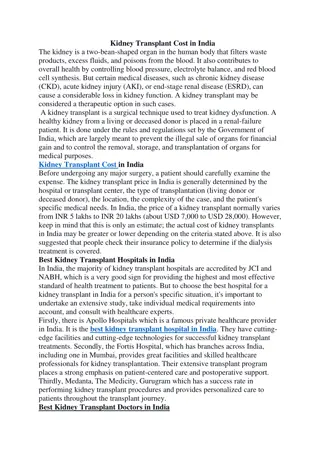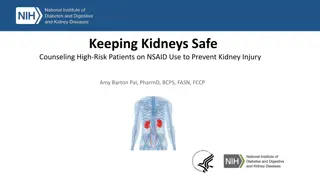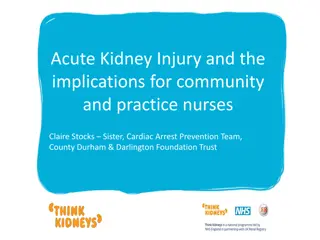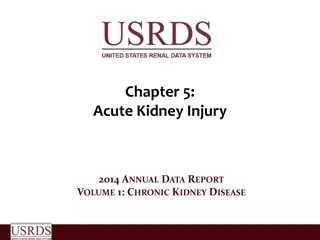Pediatric Acute Kidney Injury Management Insights
Explore supportive therapies, stage-based management, natural history, and challenges in Acute Kidney Injury (AKI) along with conservative and pharmacotherapeutic approaches. Learn about the role of diuretics, considerations in established AKI management, and historical perspectives on kidney therapies like the Kolff Rotating Drum Kidney.
Download Presentation

Please find below an Image/Link to download the presentation.
The content on the website is provided AS IS for your information and personal use only. It may not be sold, licensed, or shared on other websites without obtaining consent from the author.If you encounter any issues during the download, it is possible that the publisher has removed the file from their server.
You are allowed to download the files provided on this website for personal or commercial use, subject to the condition that they are used lawfully. All files are the property of their respective owners.
The content on the website is provided AS IS for your information and personal use only. It may not be sold, licensed, or shared on other websites without obtaining consent from the author.
E N D
Presentation Transcript
Pediatric Acute Kidney Injury: Supportive Therapies Jordan M. Symons University of Washington School of Medicine Seattle Children s Hospital
Stage-Based Management of AKI Kidney Intl Supplements (2012) 2: 19-36
Natural History of Acute Kidney Injury (AKI)
What Goes Wrong in AKI? Volume issues Volume overload Pulmonary edema Tissue edema Congestive heart failure Hypertension (+/-) Metabolic issues Chemical imbalance Hyperkalemia Metabolic acidosis Hyperphosphatemia Hyponatremia Uremic symptoms
Conservative Management of Established AKI: Diuretics Increase urine output Improve fluid balance Permit delivery of fluid to patient Nutrition, other therapies May augment loss of potassium
Do Diuretics Help in AKI?Bagshaw CCM 2008 36(4) 1. Majority of ICU patients get diuretics 8 non-randomized studies 2. But no improvement in clinical outcomes 6 randomized studies
Management of Established AKI: Pharmacotherapy Attempted Therapies Diuretics Mannitol Dopamine Fenoldopam Glucocorticoids Atrial natriuretic peptide N-acetylcysteine (other than contrast-induced AKI Definitive Therapies Hmmmm . . . . .
Conservative Management of Established AKI: Traditional Approach Limit fluid intake Limit input of retained substances Augment losses (diuretics) Try not to mess up Wait and Hope
Kolff Rotating Drum Kidney: 1940s
From Patient ~20 meters of sausage casing (2.4m2) Prime volume 2 liters Clearance 140 170 ml/min Back To Patient First 16 patients died
Goals of Renal Replacement Therapy (RRT) Restore fluid, electrolyte and metabolic balance Remove endogenous or exogenous toxins as rapidly as possible Permit needed therapy and nutrition Limit complications
RRT Options in AKI Hemodialysis, Peritoneal Dialysis, CRRT Each has advantages & disadvantages Modality choice guided by Patient Characteristics Disease/Symptoms Hemodynamic stability Goals of therapy Fluid removal, electrolyte correction, or both Availability, expertise and cost Walters et. al. Pediatr Nephrol 2008
Hemodialysis Blood perfuses extracorporeal circuit Machine mixes dialysate on-line High efficiency system Requires vascular access; anticoagulation Technically complex May be poorly tolerated by critically ill patient Time Remaining: 1:30 Blood Flow Rate: 300 ml/min Dialysate Flow Rate: 500 ml/min Ultrafiltration Rate: 0.3 L/hr Total Ultrafiltrate: 1.5 L/hr
Peritoneal Dialysis Sterile dialysate introduced into peritoneal cavity through a catheter Possibly better tolerated Lots of pediatric experience in chronic setting Low efficiency system Risk for infection Dialysate Peritoneal Space Effluent Collection
Continuous Renal Replacement Therapy (CRRT) Common ICU modality Technically similar to HD SLOW: ?Better tolerated by ICU patient? CONTINUOUS: Preserve metabolic stability; maintain fluid balance for oliguric patients who require high daily input (IV medications, parenteral nutrition)
RRT for AKI: Which Modality is Best? In-hospital mortality No Difference in Survival Rabindranath et al., Cochrane Database of Systematic Reviews (2007)
RRT for AKI: Which Modality is Best? Survival by Modality 100% Years of study: 1992-1998 N=226; Mean age 6y; Mean wt 25kg 90% 80% 70% P<0.01 (HD vs other) 60% 50% 81% 40% 30% 49% 20% 40% 10% 0% Hemofiltration (N=106) Peritoneal Dialysis (N=59) Hemodialysis (N=61) Bunchman et al., Pediatr Nephrol (2001) 16:1067 1071
Overall survival was 58% across all centers CJASN 2007 2:732-8
Impact of Volume Overload Foland JA et al: Crit Care Med 2004 Gillespie R et al: Pediatr Nephrol 2004 Sutherland et al: AJKD 2010 Volume Overload is the Enemy Goldstein SL et al: Pediatrics 2001 N=113*p=0.02; **p=0.01 Hazard Ratio 3.02 (1.50-6.10) Kaplan-Meier survival estimates, by percentage fluid overload category
Higher Dose: A Better Outcome? Hazard Ratio (95% CI) N=425 1 Group 1 Group 2 Group 3 0.51 (0.35-0.72) 0.49 (0.35-0.69) Group 1: 20ml/kg/hr Ronco, et al. Lancet 2000 Group 2: 35ml/kg/hr Group 3: 45ml/kg/hr
Intensity of Renal Replacement in AKI: No Difference? VA/NIH Acute Renal Failure Trial Network, NEJM, 2008 RENAL Replacement Therapy Study Investigators, NEJM, 2009
High Dose of CRRT for Pediatric Patients CRRT Dose N Survivors Hazard Ratio (95% CI)* Low Dose <25.6ml/kg/hr 43 23 0.810 (0.418-1.57) High Dose >25.6ml/kg/hr 44 17 1.23 (0.637-2.39) *p=0.533 Gillespie, Pediatr Nephrol 2004
RRT: Effective But Not Perfect Strengths Weaknesses Adapted equipment Nothing specific for smaller children No auto-feedback Targets programmed by provider Blunt metabolic control Hard to fine-tune Does not effectively address immune issues Volume control Fluid removal from vascular compartment Metabolic control Electrolyte removal Uremic retention molecule removal
A Dedicated Neonatal CRRT Machine? Lines and filters to limit extracorporeal blood volume Hardware and software accurate for low flows and low UF volumes Dedicated rather than adapted Safe and reliable Claudio Ronco with the Cardio Renal Pediatric Dialysis Emergency Machine (CARPEDIEM)
Summary Current approach to AKI is supportive, addressing issues after AKI established PD, HD, and CRRT can all have a role Clear ability to control volume Evidence for metabolic control Goals for dose in AKI remain unclear New technology may offer opportunities for broader application & improved care
Early dialysis with Kolff artificial kidney, Mt Sinai Hospital, New York, 1948























